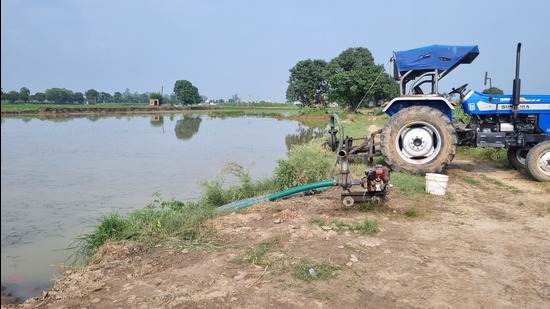Haryana: As floodwater recedes, protecting standing paddy crop an uphill task for farmers
After the water receded, Haryana farmers are facing another challenge of protecting the crop from the impact of floodwater. They are now digging roads, pumping out excess water and using fertilisers to protect the crop from sand.
Even as water has receded from most of the affected areas, farmers’ woes are far from over as the sand deposited by the floods pose a serious threat to the standing paddy crop, leaving thousands of cultivators of northern districts high and dry.

After the water receded, farmers are facing another challenge of protecting the crop from the impact of floodwater. They are now digging roads, pumping out excess water and using fertilisers to protect the crop from sand.
Reports from the flood-affected areas of Karnal, Kurukshetra, Kaithal and Yamunanagar districts, revealed that the impact of alluvium silt left behind by the floodwaters on a huge chunk of area under paddy cultivation is severe as farmers of the region are fearing total damage to their crop due to water stagnation.
“My paddy on four acres has been damaged,” said farmer Ram Pal of Radaur, Yamunanagar.
Another farmer, Madan Lal from Karnal’s Indri said, “My crop on eight acres was under four feet water for the past one week. Besides the rent, I have already spent around ₹12,000 per acre on puddling, transplantation and fertilisers to nurture the crop. Though the water has receded, the impact on the crop is so severe that we fear the crop won’t survive.”
Moreover, farmers were also spending on diesel to pump out floodwater from their fields.
“I spent ₹7,000 on diesel to pump out the excess water from my three acres of paddy but the crop on two acres has already been damaged and now we have to sow the crop again,” said another farmer, Kuldeep Singh.
The affected farmers, however, said that the paddy transplantation could be done by the first week of August, but the availability of nursery and labour is a big challenge and farmers are now spending ₹3,000 to ₹4,000 to get paddy nursery for one acre.
Nirmal Singh, a farmer leader associated with BKU (Charuni), said around 80% of the paddy transplantation was completed. But a huge area under paddy has been damaged by the flood. It is challenging for farmers to get a nursery. “Also, if they sow today, it will take about a month to get ready for transplantation. Getting required labour for the task is another challenge,” he added.
Farmers were waiting for the government to announce financial assistance for which a special girdawari is required.
Though the exact crop loss could be ascertained only after the special girdawari, the initial reports suggest damage to 5 lakh acres of standing crop in Kurukshetra, Ambala, Kaithal, Karnal, Ambala and Yamunanagar districts.
“As per our assessment, around 50,000 acres of paddy in Kaithal district have suffered 100% loss. Now farmers are left with no other option but to sow the crop again,” said Karam Chand, deputy director agriculture and farmers welfare department, Kaithal.






